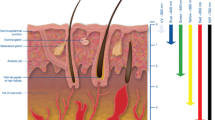Abstract
To study the electromagnetic response of natural structures that exhibit interesting optical properties, we developed a computational tool to solve the problem of electromagnetic scattering by a rough interface between two isotropic media, based on the Rayleigh method. The key aspect of the developed formalism is its capability of introducing the interface profile within the code by means of a digitalized image of the structure, which can be either obtained from an electron microscopy image or simply by design according to the complexity of the scattering surface. As application examples, we show the results obtained for surfaces taken directly from microscopy images of two different biological species. This approach constitutes a fundamental step in order to model the electromagnetic response of natural photonic structures.
Graphic Abstract











Similar content being viewed by others
Code availability
All the codes for reproducing the analyses in this article are available from the corresponding author upon reasonable request.
References
A. Parker, J. Opt. A 2, R15–R28 (2000)
M. Srinivasarao, Chem. Rev. 99, 1935–1962 (1999)
P. Vukusic, J.R. Sambles, Nature 424, 852–855 (2003)
S. Kinoshita, Structural Colors in the Realm of Nature (World Scientific, Singapore, 2008)
S. Berthier, Iridescences, the Physical Colours of Insects (Springer, Berlin, 2007)
S.M. Doucet, M.G. Meadows, J. R. Soc. Interface 6, S115–S132 (2009)
J.D. Forster, H. Noh, S.F. Liew, V. Saranathan, C.F. Schreck, L. Yang, J.-G. Park, R.O. Prum, S.G.J. Mochrie, C.S. O’Hern, H. Cao, E.R. Dufresne, Adv. Mater. 22, 2939–2944 (2010)
A. Saito, Sci. Technol. Adv. Mater. 12, 064709 (2011)
M. Iwata, M. Teshima, T. Seki, S. Yoshioka, Y. Takeoka, Adv. Mater. 29, 1605050 (2017)
M. Xiao, Z. Hu, Z. Wang, Y. Li, A. Diaz-Tormo, N. Le-Thomas, B. Wang, N.C. Gianneschi, M.D. Shawkey, A. Dhinojwala, Sci. Adv. 3, e1701151 (2017)
Y. Wang, H. Cui, Q. Zhao, X. Du, Matter 1, 1–13 (2019)
A. McDougal, B. Miller, M. Singh, M. Kolle, J. Opt. 21, 073001 (2019)
P. Vukusic, D.G. Stavenga, J. R. Soc. Interface 6, S133–S148 (2009)
L. Li, J. Opt. Soc. Am. A 10, 2581–2591 (1993)
D.C. Skigin, R.A. Depine, Opt. Commun. 149, 117–126 (1998)
M.G. Moharam, T.K. Gaylord, J. Opt. Soc. Am. A 71, 811–818 (1981)
J. Chandezon, M. Dupuis, G. Cornet, D. Maystre, J. Opt. Soc. Am. 72, 839–846 (1982)
R.A. Depine, M.E. Inchaussandague, J. Opt. Soc. Am. A 11, 173–180 (1994)
A.A. Maradudin, T.R. Michel, A.R. McGurn, E.R. Mndez, Ann. Phys. 203, 255–307 (1990)
G. Schmidt, B.H. Kleemann, J. Mod. Opt. 58, 407–423 (2011)
A. Taflove, S.C. Hagness, Computational Electrodynamics: The Finite-Difference Time-Domain Method (Artech, London, 2005)
M. Kolle, Photonic Structures Inspired by Nature (Springer, Berlin, 2011)
M.F. Su, I. El-Kady, D.A. Bader, S. Lin, Proceedings of the 33rd International Conference on Parallel Processing (ICPP), Montreal. (2004), p. 373–379
A.E. Dolinko, D.C. Skigin, J. Opt. Soc. Am. A 30, 1746–1759 (2013)
A.E. Dolinko, D.C. Skigin, M.E. Inchaussandague, C. Carmarn, Opt. Express 20, 15139–15148 (2012)
M.E. Inchaussandague, D.C. Skigin, A.E. Dolinko, Appl. Opt. 56, 5112–5120 (2017)
L. Rayleigh, Proc. R. Soc. Lond. Ser. A 79, 399 (1907)
L. Kazandjian, Phys. Rev. E 54, 6802 (1996)
A.V. Tishchenko, Opt. Express 17, 17102 (2009)
A.V. Tishchenko, Opt. Photonics News 21(7), 17102 (2010)
M. Born, E. Wolf, Principles of Optics (Pergamon Press, Oxford, 1980)
F. Toigo, A. Marvin, V. Celli, N.R. Hill, Phys. Rev. B 15(12), 5618 (1977)
M. Lester, R.A. Depine, Opt. Commun. 127, 189 (1996)
V. Grnhut, R.A. Depine, Eur. J. Phys. D 62, 227 (2011)
V. Grnhut, R.A. Depine, Appl. Opt. 51, 3470 (2012)
D.C. Skigin, R.A. Depine, Opt. Commun. 130, 307 (1996)
D.C. Skigin, R.A. Depine, J. Mod. Opt. 44, 1023 (1997)
M.E. Inchaussandague, D.C. Skigin, A. Tolivia, I. Fuertes Vila, V. Conforti, Proc. SPIE 9055, 905514 (2014)
M.E. Inchaussandague, M.L. Gigli, D.C. Skigin, A. Tolivia, V. Conforti, Proc. SPIE 9429, 94290D (2015)
A. Dolinko, C. Valencia, D.C. Skigin, M.E. Inchaussandague, A. Tolivia, V. Conforti, Proc. SPIE 9531, 953144 (2015)
M.E. Inchaussandague, D.C. Skigin, A.E. Dolinko, Appl. Opt. 56, 5112 (2017)
Acknowledgements
The authors gratefully acknowledge partial support from Universidad de Buenos Aires (UBACyT 20020150100028BA and 20020190100108BA) and from Consejo Nacional de Investigaciones Científicas y Técnicas (CONICET PIP 11220170100633CO).
Author information
Authors and Affiliations
Contributions
All the authors were involved in the preparation of the manuscript. D.C.S. and M.S.V. conceived the presented idea. M.S.V. developed the theory and performed the simulations. A.E.D. provided the validation results. D.C.S. supervised the findings of this work. All authors discussed the results and contributed to the final version of the manuscript.
Corresponding author
Appendices
Appendix A
We give here the explicit expressions for the kernel functions of Eqs. (7) and (8).
where
and
\(D\left[ u,v \right] \) is the Fourier transform of \(e^{-ivg(x)}\). Taking into account the particular expression for g(x) given in Eq. (1), it can be shown by elementary calculations that:
where
The inhomogeneity in Eq. (7) is
where
Appendix B
Substituting \( R(\alpha )\) from Eq. (9) into Eq. (7), and taking into account the expression of Eq. (A.5) and that \( R^{(0)}=-N_{\alpha _0,\alpha _0}/M_{\alpha _0,\alpha _0}\), Eq. (13) is obtained. The expression of \(b_R(\alpha ')\) in the right-hand side of Eq. (13) is:
Analogously, substituting \(T(\alpha )\) from Eq. (10) into Eq. (8) and taking into account that \(T^{(0)}=-\frac{\gamma _2}{\gamma _1}2\beta _0^{(1)}/M_{\alpha _0,\alpha _0}\), Eq. (14) is obtained, where \(b_T(\alpha ')\) is given by:
Rights and permissions
About this article
Cite this article
Vidal, M.S., Dolinko, A.E. & Skigin, D.C. Rayleigh method adapted for the study of the optical response of natural photonic structures. Eur. Phys. J. E 44, 118 (2021). https://doi.org/10.1140/epje/s10189-021-00124-8
Received:
Accepted:
Published:
DOI: https://doi.org/10.1140/epje/s10189-021-00124-8




